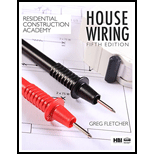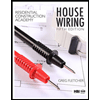
Residential Construction Academy: House Wiring (MindTap Course List)
5th Edition
ISBN: 9781337402415
Author: Gregory W Fletcher
Publisher: Cengage Learning
expand_more
expand_more
format_list_bulleted
Concept explainers
Question
Chapter 5, Problem 28RQ
To determine
The electrical symbol for a “range outlet.”
Expert Solution & Answer
Want to see the full answer?
Check out a sample textbook solution
Students have asked these similar questions
Question 4
An engineer is assigned to design a 25-stories office building which has a
building height of 75 m. Reinforced concrete shear wall system as shown in
Figure Q1(a) is adopted to resist the lateral loads. The shear wall is of
thickness t = 350 mm and length L = 8.5 m. Use the following data: Young's
modulus of concrete E = 28 kN/mm² and the lateral load intensity w = 1.20
kN/m². Assuming the frontal width of the building façade is 15 m is facing
the wind force which in turn transmitting the wind force
to the shear wall system, estimate the total value of
sway A at the roof level.
Question 6
If the similar building in Question 4 is designed using rigid
frame method is to be designed to ensure the sway is within
the allowable limit. If the building width is B, and with the
same building height H=75m. Using a rough estimation
method, calculate the maximum allowable
deflection A at the roof level.
(A)
9.46 mm
(B)
189.26 mm
(C)
14.20 mm
町
141.95 mm
1ST STOREY
FLOOR LEV.
Shear wall…
What are the biggest challenges estimators' face during the quantity takeoff and pricing phases?
Question IV (30%):
A 22 m thick normally consolidated clay layer has a
load of 150 kPa applied to it over a large areal extent. The clay layer is located below a
3.5 m thick granular fill (p= 1.8 Mg/m³). A dense sandy gravel is found below the clay.
The groundwater table is located at the top of the clay layer, and the submerged density
of the clay soil is 0.95 Mg/m³. Consolidation tests performed on 2.20 cm thick doubly
drained samples indicate the time for 50% consolidation completed as t50 = 10.5 min for
a load increment close to that of the loaded clay layer. Compute the effective stress in
the clay layer at a depth of 16 m below the ground surface 3.5 years after the
application of the load.
Chapter 5 Solutions
Residential Construction Academy: House Wiring (MindTap Course List)
Ch. 5 - Prob. 1RQCh. 5 - Prob. 2RQCh. 5 - Prob. 3RQCh. 5 - Prob. 4RQCh. 5 - Prob. 5RQCh. 5 - Prob. 6RQCh. 5 - Prob. 7RQCh. 5 - Prob. 8RQCh. 5 - Prob. 9RQCh. 5 - Prob. 10RQ
Ch. 5 - Prob. 11RQCh. 5 - Prob. 12RQCh. 5 - Prob. 13RQCh. 5 - Prob. 14RQCh. 5 - Prob. 15RQCh. 5 - Prob. 16RQCh. 5 - Prob. 17RQCh. 5 - Prob. 18RQCh. 5 - Prob. 19RQCh. 5 - Prob. 20RQCh. 5 - Prob. 21RQCh. 5 - Prob. 22RQCh. 5 - Prob. 23RQCh. 5 - Prob. 24RQCh. 5 - Prob. 25RQCh. 5 - Prob. 26RQCh. 5 - Prob. 27RQCh. 5 - Prob. 28RQCh. 5 - Prob. 29RQCh. 5 - Prob. 30RQ
Knowledge Booster
Learn more about
Need a deep-dive on the concept behind this application? Look no further. Learn more about this topic, civil-engineering and related others by exploring similar questions and additional content below.Similar questions
- 13-3. Use the moment-distribution method to determine the moment at each joint of the symmetric bridge frame. Supports at F and E are fixed and B and C are fixed connected. Use Table 13-2. The modulus of elasticity is constant and the members are each 0.25 m thick. The haunches are parabolic. *13-4. Solve Prob. 13-3 using the slope-deflection equations. 13 0.5 m 1 m 64 kN/m D BC 1.5 m 2.25 m 2 m 6.25 m -0.5 m E -7.5 m -10 m- -7.5 m. Probs. 13-3/4arrow_forward2. Find the equivalent concentrated load(s) for the bags of cement stacked on the dock as shown here. Each bag weighs 100 lbs and is 12 inches long. Draw the loading conditions for each showing the equivalent concentrated load(s). 1 bag = 100lbs L= 12 ft L= 6 ft L= 8ftarrow_forwardI have a question for this problem in the first one wouldn't it be finding the total weight of the bags which =4800lbs and the multiply that by 12ft to find the concentrated load?? but if this is the case the load would end up as lbs/ft so I'm not too sure that is right.arrow_forward
- Q.2 The girder AB as shown in Fig. 2 has a span of 18m and supports concentrated loads located as shown. Determine the plastic moment capacity MP and the plastic collapse load Pc for the given load conditions. Use either Equilibrium drVirtual Work method in your solution. [30 marks] 5P 5P C d B 6 m 6 m 6 m 18 m Fig. 2 - Prismatic Continuousarrow_forward337 kN -Weld -25° 6 mm PROBLEM 1.33 A steel pipe of 300 mm outer diameter is fabricated from 6 mm thick plate by welding along a helix which forms an angle of 25° with a plane perpendicular to the axis of the pipe. Knowing that the maximum allowable normal and shearing stresses in directions respectively normal and tangential to the weld are σ = 50 MPa and 7 = 30 MPa, determine the magnitude P of the largest axial force that can be applied to the pipe.arrow_forward2.2 Identify the Zero Force Members for the truss shown. Show your final answer with a sketch and mark the zero force bars with "0". D 700 N 500 Narrow_forward
- 1. (a) Explain Rankine's Theory of lateral earth pressures (at rest, active and passive) in terms of Mohr's circles. (6%) (b) What are the two important assumptions of Rankine in determination of lateral earth pressures on a retaining structure? (4%) (c) Show all the pressures acting on the wall below and determine them (30%) 0.5m 10 5.0 m 1.0 m Sand Y-18.5 kN/m³ $-36° Tos m 1.5m 1.0 m 1.0 marrow_forward100% sure experts solve it correct complete solutions okk. Not generalizedarrow_forward2) Draw the shear force and bending moment diagrams of the following beam. Use method of areas. 5 t/m Z 10t hinge 5 m |1m|1m|1m m+ 2 m 21 A- All electronic communication tools like mobile phones, computers, tablets, etc. will not be in an open and visible area during the exam. B- According to the provision of Article (a-5) of the Higher Education Law No. 2547, "Attempting to cheat in exams" is a disciplinary offense that requires "Condemnation punishment". C- According to the provisi Article 54-(c-5) of the Higher Education Law No. 2547, "Cheating or causing others to cheat in exams" is a disciplinary offense that requires "Suspension from the Hi Education Institution for one semester". D- According to the provision of Article 54-(d-4) of the Higher Education Law No. 2547, "Cheating in exams by threatening, prever cheating students from being removed from the exam hall, having someone else take the exam instead of oneself or taking the exam in someone else's place" is a discipl offense…arrow_forward
arrow_back_ios
SEE MORE QUESTIONS
arrow_forward_ios
Recommended textbooks for you
 Residential Construction Academy: House Wiring (M...Civil EngineeringISBN:9781337402415Author:Gregory W FletcherPublisher:Cengage Learning
Residential Construction Academy: House Wiring (M...Civil EngineeringISBN:9781337402415Author:Gregory W FletcherPublisher:Cengage Learning Residential Construction Academy: House Wiring (M...Civil EngineeringISBN:9781285852225Author:Gregory W FletcherPublisher:Cengage Learning
Residential Construction Academy: House Wiring (M...Civil EngineeringISBN:9781285852225Author:Gregory W FletcherPublisher:Cengage Learning Architectural Drafting and Design (MindTap Course...Civil EngineeringISBN:9781285165738Author:Alan Jefferis, David A. Madsen, David P. MadsenPublisher:Cengage Learning
Architectural Drafting and Design (MindTap Course...Civil EngineeringISBN:9781285165738Author:Alan Jefferis, David A. Madsen, David P. MadsenPublisher:Cengage Learning

Residential Construction Academy: House Wiring (M...
Civil Engineering
ISBN:9781337402415
Author:Gregory W Fletcher
Publisher:Cengage Learning

Residential Construction Academy: House Wiring (M...
Civil Engineering
ISBN:9781285852225
Author:Gregory W Fletcher
Publisher:Cengage Learning

Architectural Drafting and Design (MindTap Course...
Civil Engineering
ISBN:9781285165738
Author:Alan Jefferis, David A. Madsen, David P. Madsen
Publisher:Cengage Learning